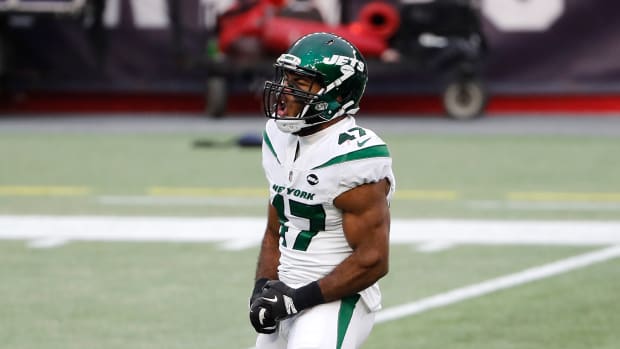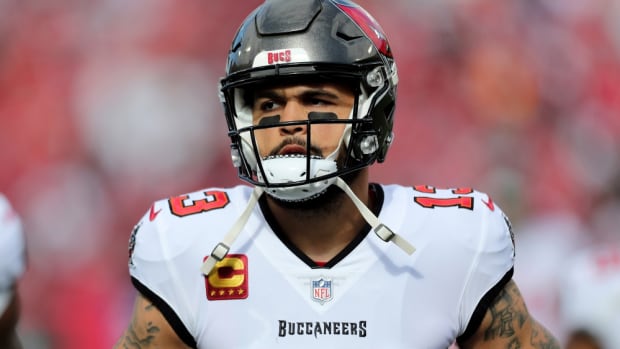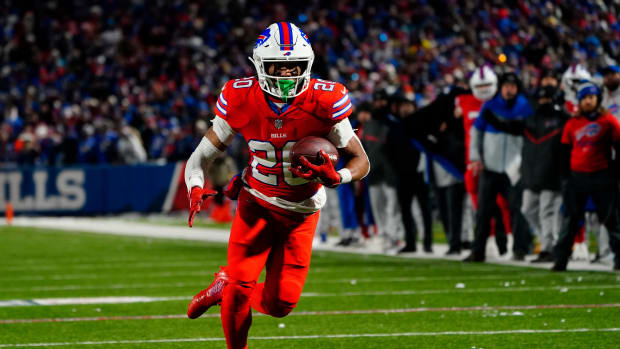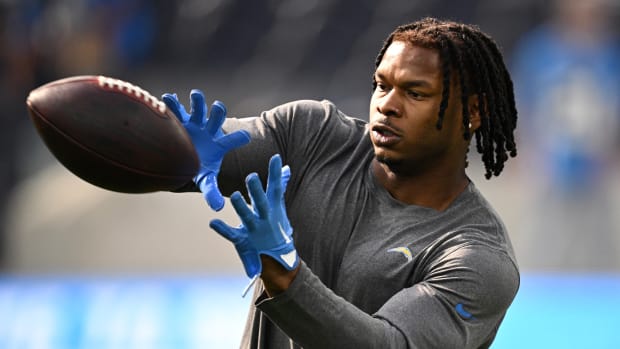Steve Smith Rules
This story appeared in the Nov. 24 issue of Sports Illustrated. To subscribe,
.
By GREG BISHOP
To survive 14 NFL seasons, play in 201 games, catch 936 passes and gain 13,781 receiving yards, a man must possess . . . something. A secret, a formula, a remedy for slowing football’s merciless aging process. Especially when that man stands just 5’ 9”. And especially when he is so—to put it mildly—outspoken.
Inside the Ravens’ cafeteria, Steve Smith leans forward at a dining table. The room is empty, but he speaks softly anyway, dressed in all black. There is no simple blueprint to football longevity, he clarifies, but there are tricks. He can, in fact, rattle 13 of them off the top of his head.
The first trick: fruits and vegetables. Smith loves them. He’s a self-described “salad guy,” partial to broccoli, asparagus, oranges and apples, and he eats like a vegetarian until dinner, when he splurges with one piece of chicken or fish. Smith cooks and bakes. He makes a mean cinnamon-apple oatmeal muffin.
The second trick: spin class. Smith disdains lifting weights and jogging, so he substitutes training methods such as boxing and plyometrics. He tried a spin class a few years ago, wearing a knit hat along with several layers of clothes, and he sweated so much that he suffered cramps. The low impact preserves his joints.
The third trick: disengagement. Smith leaves football at the team facility. “I actually love to read,” he says, citing business texts such as The Richest Man in Babylon and motivational works like A Tale of Three Kings and The Last Lecture among his favorite books. He collects passport stamps, traveling through China, Italy, Australia and all over Africa; he’s been to Jerusalem, Barcelona, London and Paris. He says things like “Tanzania is known for tanzanite.” At one point Smith pauses because he knows this all sounds strange coming from, well, Steve Smith. “There’s a perception of me that I’m a hothead and an idiot,” he says. “That because I’m aggressive on the football field, I’m a thug. But look, just because you see me [doing one thing] in my workplace doesn’t mean I walk around stiff-arming people and spinning cantaloupe in the grocery store.”
That, of course, is what the 35-year-old Smith is known for, a career spent in perpetual combat: three documented fistfights with teammates, scores of altercations with opponents, countless spins of the football in defiant celebration after every catch, even in practice. That’s the fourth trick: play angry, no matter how it looks. It’s gotten Smith this far, to
No. 16 on the NFL’s alltime receiving yards list, ahead of Art Monk and Irving Fryar, within striking distance of Steve Largent and Andre Reed.
The fifth trick: collect quotes. Smith stores dozens of them in a folder on his smartphone, from the Bible and football coaches and philosophers, and he will glance at them in moments that require inspiration, affirmation, guidance. The origin of his favorite quote is unknown: “Never be ashamed of a scar. It simply means you were stronger than whatever tried to hurt you.”
“I’ve got some scars,” Smith says.
* * *
Steve Smith’s NFL career started in Carolina in 2001. He led the Panthers to Super Bowl XXXVIII in ’03 (where they lost to the Patriots) and the NFC championship game in ’05 (where they lost to the Seahawks), the same year that he led the league in receptions (103), receiving yards (1,563) and touchdown catches (12), a receiver’s triple crown.
In the 2010 off-season Smith traveled to Australia, and on the flight he was seated next to the agent for one of his own celebrity superfans: John Isner. A 6’ 10” professional tennis player, and now the highest-ranked American male, Isner (who grew up in Greensboro, N.C.) had been a die-hard Panthers supporter since the team’s inception, in 1995. The agent played matchmaker, and Smith watched the Australian Open that year from Isner’s box. Isner later attended Smith’s practices, and they swapped tennis rackets for game-worn cleats. Isner says that his signed number 89 Panthers jersey is among the first things he would grab if his house ever caught on fire.
For all that separated Smith and Isner—13 inches in height and about 2,500 miles, from Greensboro to Smith’s hometown of Los Angeles—the two men weren’t so different. They shared faith and family and Carolina football. “I think Steve is the greatest Panther ever,” Isner says.
“There’s a perception of me that I’m a hothead and an idiot,” Steve Smith says. “That because I’m aggressive on the football field, I’m a thug. But look...you want to put me in a box; I refuse to be put there.”
Was the greatest. The Smith-Carolina union started to crumble in February, after 13 seasons. Steve and his wife, Angie, were holed up in a Park City, Utah, hotel room, on vacation, when they first started reading reports in which Panthers execs were noncommittal about the receiver’s future with the team. In March he found out he’d been released—on the radio.
The Panthers said it wasn’t personal, but it felt that way. The rationalizations trickled in from sources within the team: Smith wasn’t a leader. He was a distraction. Quarterback Cam Newton, with whom he had publicly argued on the sidelines, could never really lead Carolina with Smith there. “Really, just trying to create a perception to justify why they let me go,” he says. “I didn’t always say things the right way; there are a lot of things I regret. But the one thing I don’t regret is how I played. Broke my forearm. Got concussions. Broke my leg in half. Played in a playoff game less than a month after a [PCL] sprain. Then, this.”
In the aftermath Smith exchanged text messages with Johnny Lundy, his close friend and former college teammate at Utah. Smith was working on his sixth trick, one he’d perfected early in life: internalize slights. “Time for me to write a new chapter,” he typed to Lundy. “Hopefully somebody gives this old dude a second chance.”
* * *
At his current pace, Smith is headed for 1,165 receiving yards. That’s no small feat—but it’s also not a record for his age. (Four receivers have topped that.) Here, the best seasons by anyone 35u00a0oru00a0older:
• Irving Fryar
Eagles WR
Age 35 in 1997
1,316 receiving yards
• John Riggins
Washington RB
Age 35 in 1984
1,239 rushing yards
• Peyton Manning
Broncos QB
Age 37 in 2013
5,477 passing yards*
• Sam Mills
Saints LB
Age 35 in 1994
115 tackles
• Trace Armstrong
Dolphins DE
Age 35 in 2000
16.5 sacks
• Ken Riley, Bengals CB; Rod Woodson, Steelers FS
36 in 1983; 37 in 2002
8 interceptions
* NFL record for any age
Follow us on Facebook, Twitter and Instagram
The day after his release, Smith scheduled a trip to Baltimore. At the airport he spoke on the phone with Bill Belichick and Mike McCoy, his first position coach in Carolina, who became the head man with the Chargers in 2013. Afterward Smith met with three members of the Ravens’ staff: coach John Harbaugh, receivers coach Bobby Engram and GM Ozzie Newsome. He was working on his seventh trick: sell yourself.
That’s what Newsome wanted. He looked Smith in the eye and told him Baltimore searched for certain kinds of players, those who exuded toughness and ran toward expectations. Players like Smith. (The Ravens, in fact, had tried to trade for him in previous seasons.) “Steve likes to express himself,” Newsome says, “and we felt we could provide an environment where Steve could be Steve.”
Without visiting any other teams, Smith signed a three-year deal for $10.5 million, with $3.5 million guaranteed, plus incentives for playing time. And Harbaugh sweetened the package with veteran perks: Smith could fly home to his family in Charlotte after away games, and he could take certain practice days off in-season to conserve energy.
At training camp, teammates approached Smith with a mixture of awe and curiosity. “I remember growing up watching him,” says second-year receiver Marlon Brown. “I’m wondering, Who’s this small guy always getting into fights with people?”
The receiver Brown saw in Baltimore carried himself the same way he had in Carolina, where one former road roommate, Kealoha Pilares, remembers Smith sitting in the front row at meetings, his chair off limits to teammates, same as the foot massager that he used throughout film sessions (that’s the eighth trick). He still boasted of his hand strength—one of the smallest guys on the field with a power handshake that made linemen cringe. He still woke up early on game days to read.
On the field, too, he was the same old Smith. He caught seven passes for 118 yards in Baltimore’s opener, six for 71 in Week 2, five for 101 in Week 3. In Week 8 he fought off a defender, hauled in a long pass, spun, shook off another defender and scored an apparent game-winning 80-yard touchdown against the Bengals, only to be whistled for offensive pass interference on a play that Harbaugh called “one of the greatest I’ve ever seen.” In Week 10, Smith body-slammed 246-pound Titans linebacker Avery Williamson on a run block, then called out Tennessee’s strength coach to reporters, just for fun. Last week he promised to spend the $5 million still owed to him by the Panthers on a bye-week vacation.
As if he hadn’t already embarrassed his former team enough. In Week 4, at home against Carolina, Smith rang up 139 receiving yards and scored twice, becoming the oldest player in NFL history to accumulate 400 receiving yards in the first four games of a season. Late in that game, cameras captured Smith on the sideline as he mimicked hammering the final nail into an imaginary coffin. “You’re dead!” he said. “Take your a-- back to Carolina. Make sure you done mow my lawn, too, while you’re out there.”
* * *
The ninth trick: expect nothing; want one thing.
Ever since he’d watched Jerry Rice, when he was a kid in L.A., Smith never wanted anything but to play football. Later, he came into possession of a football card: carl pickens, 1,000-yard club. He wanted to join.
Back then he went by Stevonne, his given name. Stevonne ran track and played football at University High in L.A., at least when he was eligible. He had some academic issues. “He was always getting in scraps, fighting all the time,” says his offensive coordinator at the time, Gifford Lindheim. “Of all the guys I’ve coached—and I’ve coached thousands—I really didn’t think he’d be the guy with a 14-year NFL career. He was out to prove everybody wrong.”
• A RAVEN’S REVENGE: Steve Smith torched his old team in September
And he did. Smith started at Santa Monica College, where he worked at Taco Bell after practice, then transferred to Utah, where he saw snow for the first time (and started going by Steve). During a punt return against BYU in 1999, Smith dipped his right shoulder into one defender while another player collided with his left shoulder. His neck bothered him, but he finished the game. X-rays later showed a broken vertebra in his neck. The 10th trick: play hurt. Availability is as important as ability.
Smith spent six weeks in traction (“He didn’t know if he would play again,” Angie says), returned for his senior season and then was selected in the third round of the 2001 NFL draft. Recalling Smith’s tricky path to professional football and his eventual release by Carolina, Lindheim says, “Here’s a guy with a reputation for losing his temper and being a great player. Yet he stayed in Carolina for 13 years. If he was that bad of a guy, they would have gotten rid of him earlier. That’s the line Steve walks. He’s not a bad guy. But you just know you don’t want to mess with that dude.”
* * *
Smith is not two people, even if it sometimes appears that way and he’s often described as such. He is one person with myriad interests and a personality that trends toward extremes. That can be confusing—the little guy barking at bigger defenders, on the hunt for his next fight, his next salad, his next spin class. Then people meet him, in the grocery store and at airports, and they deliver backhanded compliments. You’re not what I thought you would be. You’re smarter than I imagined. You’re not that bad of a guy.
“We live in a society where people have preconceived notions, where it’s O.K. to judge,” Smith says. “You think I’m extreme; I think I’m normal. You want to put me in a box; I refuse to be put there.”
Early in his career Smith watched teammates go broke, their bank accounts drained by lavish purchases and poor investments. He made a few himself. Then he hired a financial guy; he interned at Morgan Stanley in consecutive off-seasons; he attended a financial seminar in London. Smith wanted to buy a Bentley, and eventually he did, but not until he accrued enough interest on his salary to buy the car outright—passive income, he notes, schooling a reporter on financial terms. That took 8 and a half years.
The calming influence, the driver behind Smith’s evolution, is Angie. The 11th trick: marry well. The couple met at Utah, married soon after and had four children. “The way my wife makes me feel is that she should be the one on the field, and I should be in the stands,” Smith says. Before his high school reunion, Smith got excited about rubbing his success in the faces of his doubters. Angie is the one who asked, Are you going with the right motives? “I can embarrass her sometimes,” he confesses when asked about the time he broke a teammate’s nose. “There have been some things in my career, in my life, where I’ve let her down.”
The 12th trick: be honest with yourself.
* * *
Smith carpools. He watches soccer tournaments. He coaches a youth flag football team. He embraces the role of suburban soccer dad.
His charity, the Steve Smith Family Foundation, helps fight homelessness and domestic violence. He holds events at shelters for battered women, and he washes their feet and buys them new shoes and hires a magician to occupy their children. “I talk to these women not as an athlete,” he says, “but as a kid who has seen and felt domestic violence.” (Smith says his mother was abused by her ex-husband, not his father.)
The juxtaposition is awkward and obvious, because Smith plays for the same team that employed Ray Rice before he knocked his fiancée out in a casino hotel elevator. Smith posted on his Twitter account shortly after that video surfaced. “Keep your damn hands off women!!!! God made women for you to Lean on them Not beat on them.”
Back at the Ravens’ facility, someone asks Harbaugh about Rice, who is testifying that afternoon in his NFL appeals hearing. The coach ducks the question. Smith does not; he goes back to a joke that he has already told about the last time he was in an elevator with his wife, headed to a hotel room. Nine months later she had the baby boy, Stevonne Jr., that they call Deuce.
Then he moves on to another topic: how long he might play. “I’m 35,” he says, a fact that he made light of this season by changing his jersey to read smith sr. “I’m going to play as long as I can, but I’m not going to lose valuable time with my family.”
The 13th trick: find a graceful way out, something to replace football as the outlet for his anger and competitive fire and aggression. That will be Smith’s next fight, after this season, or the next, or the season after that. Then he’s off into retirement. Salads beckon. So does spin class.
Follow The MMQB on Facebook, Twitter and Instagram.
[widget widget_name="SI Newsletter Widget”]











































